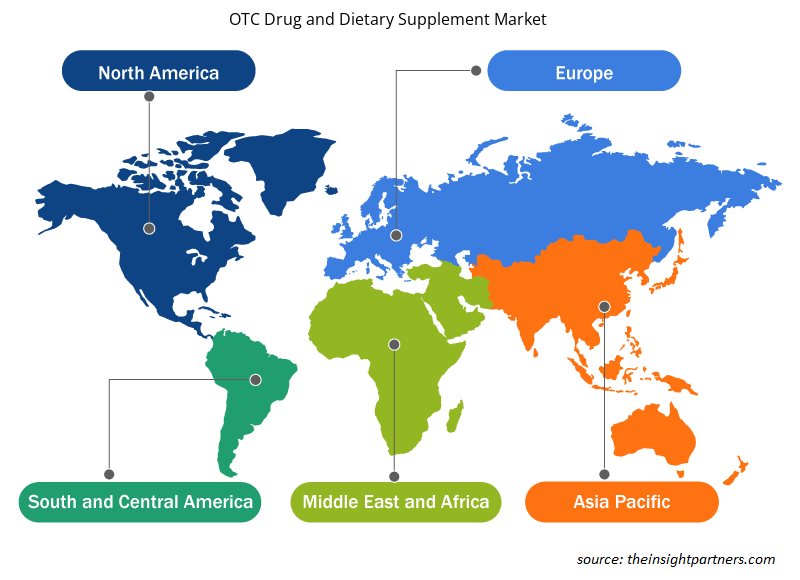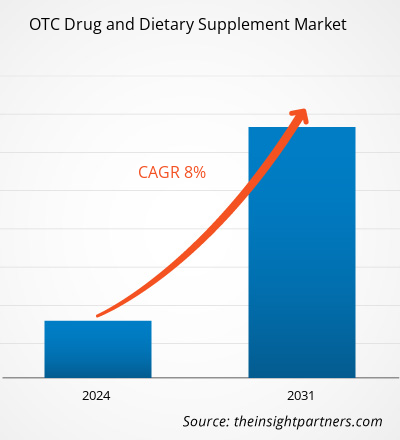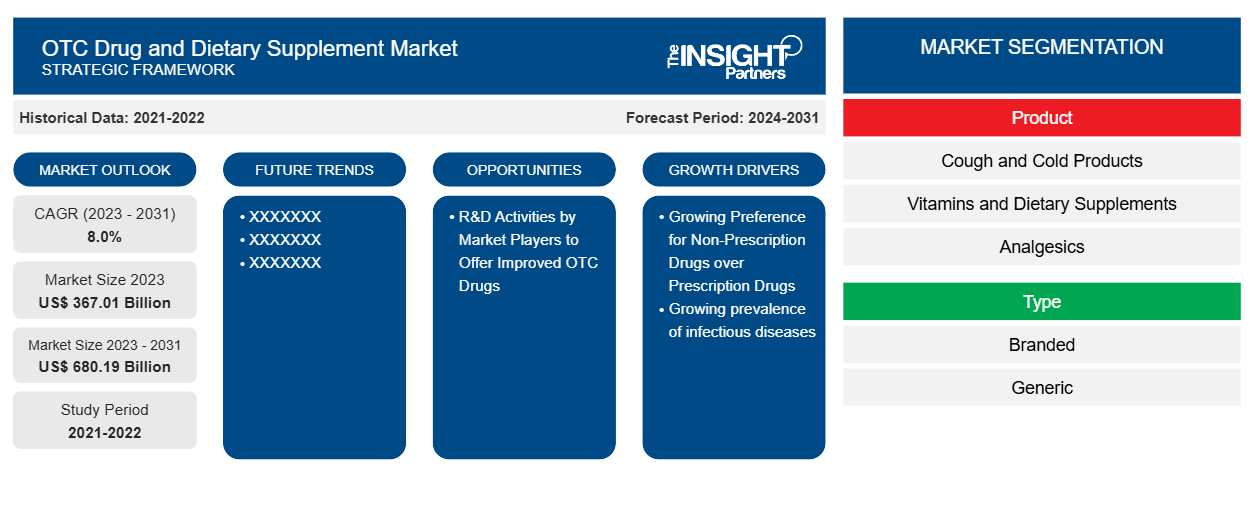El tamaño del mercado de medicamentos de venta libre y suplementos dietéticos se estimó en US$ 367.01 mil millones en 2023 y se espera que alcance los US$ 680.19 mil millones para 2031; se estima que registrará una CAGR del 8,0% hasta 2031. Es probable que la selección de medicamentos de venta libre para enfermedades menores siga siendo una tendencia clave del mercado de medicamentos de venta libre y suplementos dietéticos.CAGR of 8.0% till 2031. Selection of OTC drugs for minor diseases is likely to remain key OTC Drug and Dietary Supplement Market trends.
Análisis del mercado de medicamentos de venta libre y suplementos dietéticos
El creciente énfasis en la atención centrada en el paciente, el avance en la tecnología sanitaria, la relación coste-eficacia de los medicamentos de venta libre y los complementos dietéticos y la creciente preferencia por la telemedicina son los principales impulsores del crecimiento del mercado de medicamentos de venta libre y complementos dietéticos. Además, el aumento de la población geriátrica, el aumento de la atención sanitaria domiciliaria y la creciente prevalencia de enfermedades crónicas e infecciosas están impulsando el crecimiento del mercado de medicamentos de venta libre y complementos dietéticos.patient-centric care, advancement in healthcare technology, cost-effectiveness of OTC drug and dietary supplements, and increasing preference for telemedicine is mainly fueling the growth of the OTC drug and dietary supplement market. In addition, increasing geriatric population, increasing
Descripción general del mercado de medicamentos de venta libre y suplementos dietéticos
Los medicamentos de venta libre (OTC) están disponibles para el público para su uso general. Los medicamentos de venta libre están disponibles para diversos síntomas médicos debidos a afecciones médicas como tos y resfriados, diarrea, acidez estomacal, estreñimiento, acné, dolor y otros. Por otro lado, los suplementos dietéticos están disponibles sin receta para fines de acondicionamiento físico. Estos medicamentos de venta libre y suplementos nutricionales son de dos tipos: de marca o genéricos.
Personalice este informe según sus necesidades
Obtendrá personalización en cualquier informe, sin cargo, incluidas partes de este informe o análisis a nivel de país, paquete de datos de Excel, así como también grandes ofertas y descuentos para empresas emergentes y universidades.
- Obtenga las principales tendencias clave del mercado de este informe.Esta muestra GRATUITA incluirá análisis de datos, desde tendencias del mercado hasta estimaciones y pronósticos.
Factores impulsores y oportunidades del mercado de medicamentos de venta libre y suplementos dietéticos
Creciente preferencia por medicamentos sin receta en lugar de medicamentos con receta
La creciente presión de los gobiernos y los consumidores para reducir los precios ayudaría a acelerar la transición de los medicamentos de venta con receta a los de venta libre (Rx-to-OTC). Existe un amplio apoyo al uso de medicamentos de venta libre entre los médicos para la fiebre, el resfriado/tos y dolencias menores de esa naturaleza; más allá de eso, los médicos tienen algunas reservas. Aunque hay medicamentos genéricos de venta con receta que son más baratos que los medicamentos de venta libre, la mayoría de los medicamentos de venta libre son más baratos que los medicamentos de venta con receta. Los medicamentos sin receta son preferidos porque están fácilmente disponibles, son más asequibles y se perciben como más naturales. La creciente preferencia por los medicamentos sin receta sobre los medicamentos de venta con receta debido a sus ventajas está impulsando el crecimiento del mercado de medicamentos de venta libre y suplementos dietéticos.
Actividades de I+D de los agentes del mercado para ofrecer medicamentos de venta libre mejorados: una oportunidad para el mercado de medicamentos de venta libre y suplementos dietéticos
La confianza de los clientes en las marcas de venta sin receta está animando a los fabricantes de medicamentos a emprender un número cada vez mayor de actividades de investigación y desarrollo de laxantes, antisépticos orales, remedios para la acidez de estómago, productos antitabaco, analgésicos y suplementos nutricionales, entre otros compuestos que se venden sin receta. Esto los ha llevado a expandir sus operaciones de fabricación e I+D. Por ejemplo, Novartis Consumer Health Inc. abrió su tercer centro mundial de investigación y desarrollo de productos de venta sin receta en Mumbai, India. En muchos países desarrollados, la gama de medicamentos de venta sin receta disponibles para los consumidores se está expandiendo. Mientras tanto, en los países emergentes, el uso de estos medicamentos está aumentando mientras que los sistemas de atención médica relacionados son estables, por lo que se espera un crecimiento en los productos de venta sin receta. Los actores clave del mercado aplican estrategias como fusiones y adquisiciones para el desarrollo del mercado de medicamentos de venta sin receta y suplementos dietéticos.
Análisis de segmentación del informe de mercado de medicamentos de venta libre y suplementos dietéticos
Los segmentos clave que contribuyeron a la derivación del análisis del mercado de medicamentos de venta libre y suplementos dietéticos son el producto, el tipo, la forma y el canal de distribución.
- Según el producto, el mercado de medicamentos de venta libre y suplementos dietéticos se segmenta en productos para la tos y el resfriado, vitaminas y suplementos dietéticos, analgésicos, productos gastrointestinales, ayudas para dormir, productos para el cuidado bucal, productos oftálmicos, antiácidos, cuidado femenino y otros. El segmento de analgésicos tuvo la mayor participación de mercado en 2023.
- Según el tipo, el mercado de medicamentos de venta libre y suplementos dietéticos se divide en genéricos y de marca. El segmento de genéricos tuvo la mayor participación de mercado en 2023.
- Por forma, el mercado se segmenta en comprimidos, cápsulas, polvos, ungüentos, líquidos y otros. El segmento de comprimidos tuvo la mayor participación del mercado en 2023.
- En términos de canal de distribución, el mercado está segmentado en farmacias hospitalarias y minoristas, tiendas minoristas, canales en línea y otros. El segmento de farmacias hospitalarias y minoristas tuvo la mayor participación del mercado en 2023.
Análisis de la cuota de mercado de medicamentos de venta libre y suplementos dietéticos por geografía
El alcance geográfico del informe del mercado de medicamentos de venta libre y suplementos dietéticos se divide principalmente en cinco regiones: América del Norte, Asia Pacífico, Europa, Medio Oriente y África, y América del Sur y Central.
América del Norte ha dominado el mercado de medicamentos de venta libre y suplementos dietéticos. En América del Norte, Estados Unidos tiene una participación significativa en el mercado de medicamentos de venta libre y suplementos dietéticos. El crecimiento en América del Norte se caracteriza por una alta prevalencia de enfermedades infecciosas, un creciente apoyo gubernamental a la industria farmacéutica, un creciente gasto en atención médica, una creciente adopción de medicamentos sin receta, una mayor adopción de servicios de telesalud, un aumento en el número de proveedores de servicios y el desarrollo de instituciones de atención médica. Por otro lado, la demanda de suplementos dietéticos es mucho mayor para todos los grupos de edad en Estados Unidos.telehealth services, increase in number of service providers, and developing healthcare institutions. On the other hand, the dietary
Perspectivas regionales del mercado de medicamentos de venta libre y suplementos dietéticos
Los analistas de Insight Partners han explicado detalladamente las tendencias y los factores regionales que influyen en el mercado de medicamentos de venta libre y suplementos dietéticos durante el período de pronóstico. Esta sección también analiza los segmentos y la geografía del mercado de medicamentos de venta libre y suplementos dietéticos en América del Norte, Europa, Asia Pacífico, Oriente Medio y África, y América del Sur y Central.

- Obtenga datos regionales específicos para el mercado de medicamentos de venta libre y suplementos dietéticos
Alcance del informe sobre el mercado de medicamentos de venta libre y suplementos dietéticos
| Atributo del informe | Detalles |
|---|---|
| Tamaño del mercado en 2023 | US$ 367.01 mil millones |
| Tamaño del mercado en 2031 | US$ 680,19 mil millones |
| CAGR global (2023 - 2031) | 8.0% |
| Datos históricos | 2021-2022 |
| Período de pronóstico | 2024-2031 |
| Segmentos cubiertos | Por producto
|
| Regiones y países cubiertos | América del norte
|
| Líderes del mercado y perfiles de empresas clave |
|
Densidad de actores del mercado: comprensión de su impacto en la dinámica empresarial
El mercado de medicamentos de venta libre y suplementos dietéticos está creciendo rápidamente, impulsado por la creciente demanda de los usuarios finales debido a factores como la evolución de las preferencias de los consumidores, los avances tecnológicos y una mayor conciencia de los beneficios del producto. A medida que aumenta la demanda, las empresas amplían sus ofertas, innovan para satisfacer las necesidades de los consumidores y aprovechan las tendencias emergentes, lo que impulsa aún más el crecimiento del mercado.
La densidad de actores del mercado se refiere a la distribución de las empresas o firmas que operan dentro de un mercado o industria en particular. Indica cuántos competidores (actores del mercado) están presentes en un espacio de mercado determinado en relación con su tamaño o valor total de mercado.
Las principales empresas que operan en el mercado de medicamentos de venta libre y suplementos dietéticos son:
- GlaxoSmithKline plc
- Sanofi
- Servicios Johnson y Johnson, Inc.
- Abad
- AbbVie Inc
- Compañías de salud Bausch Inc.
Descargo de responsabilidad : Las empresas enumeradas anteriormente no están clasificadas en ningún orden particular.

- Obtenga una descripción general de los principales actores clave del mercado de medicamentos de venta libre y suplementos dietéticos
Noticias y desarrollos recientes del mercado de medicamentos de venta libre y suplementos dietéticos
El mercado de medicamentos de venta libre y suplementos dietéticos se evalúa mediante la recopilación de datos cualitativos y cuantitativos posteriores a la investigación primaria y secundaria, que incluye publicaciones corporativas importantes, datos de asociaciones y bases de datos. A continuación, se incluye una lista de los avances en el mercado de antígenos virales y estrategias:
- Emcure Pharmaceuticals anunció su ingreso al mercado de medicamentos de venta libre (OTC) con su producto Galact. Enriquecido con la potencia de Shatavari y otras seis hierbas, Galact está meticulosamente formulado para aumentar la producción de leche materna en las madres. (Fuente: Nuffoods Spectrum, comunicado de prensa, 2024)
- McKesson lanzó su gama Foster & Thrive de productos de salud y bienestar de venta libre (OTC) de marca privada. Según la empresa, la nueva marca unificará la cartera de marcas privadas de McKesson, que incluye productos OTC vendidos bajo las marcas Health Mart y Sunmark. (Fuente: Bareback Media Pvt. Ltd, comunicado de prensa, 2023)
Informe sobre el mercado de medicamentos de venta libre y suplementos dietéticos: cobertura y resultados
El informe “Tamaño y pronóstico del mercado de medicamentos de venta libre y suplementos dietéticos (2021-2031)” proporciona un análisis detallado del mercado que cubre las siguientes áreas:
- Tamaño del mercado y pronóstico a nivel global, regional y nacional para todos los segmentos clave del mercado cubiertos bajo el alcance
- Dinámica del mercado, como impulsores, restricciones y oportunidades clave
- Principales tendencias futuras
- Análisis detallado de las cinco fuerzas de Porter y PEST y FODA
- Análisis del mercado global y regional que cubre las tendencias clave del mercado, los principales actores, las regulaciones y los desarrollos recientes del mercado.
- Análisis del panorama de la industria y de la competencia que abarca la concentración del mercado, el análisis de mapas de calor, los actores destacados y los desarrollos recientes
- Perfiles detallados de empresas
- Análisis histórico (2 años), año base, pronóstico (7 años) con CAGR
- Análisis PEST y FODA
- Tamaño del mercado, valor/volumen: global, regional y nacional
- Industria y panorama competitivo
- Conjunto de datos de Excel
Informes recientes
Informes relacionados
Testimonios
Razón para comprar
- Toma de decisiones informada
- Comprensión de la dinámica del mercado
- Análisis competitivo
- Información sobre clientes
- Pronósticos del mercado
- Mitigación de riesgos
- Planificación estratégica
- Justificación de la inversión
- Identificación de mercados emergentes
- Mejora de las estrategias de marketing
- Impulso de la eficiencia operativa
- Alineación con las tendencias regulatorias























 Obtenga una muestra gratuita para - Mercado de medicamentos de venta libre y suplementos dietéticos
Obtenga una muestra gratuita para - Mercado de medicamentos de venta libre y suplementos dietéticos